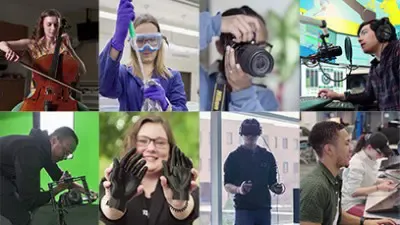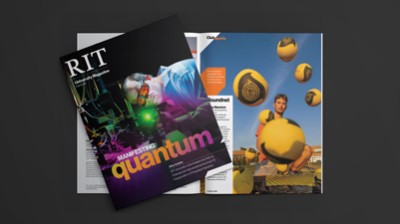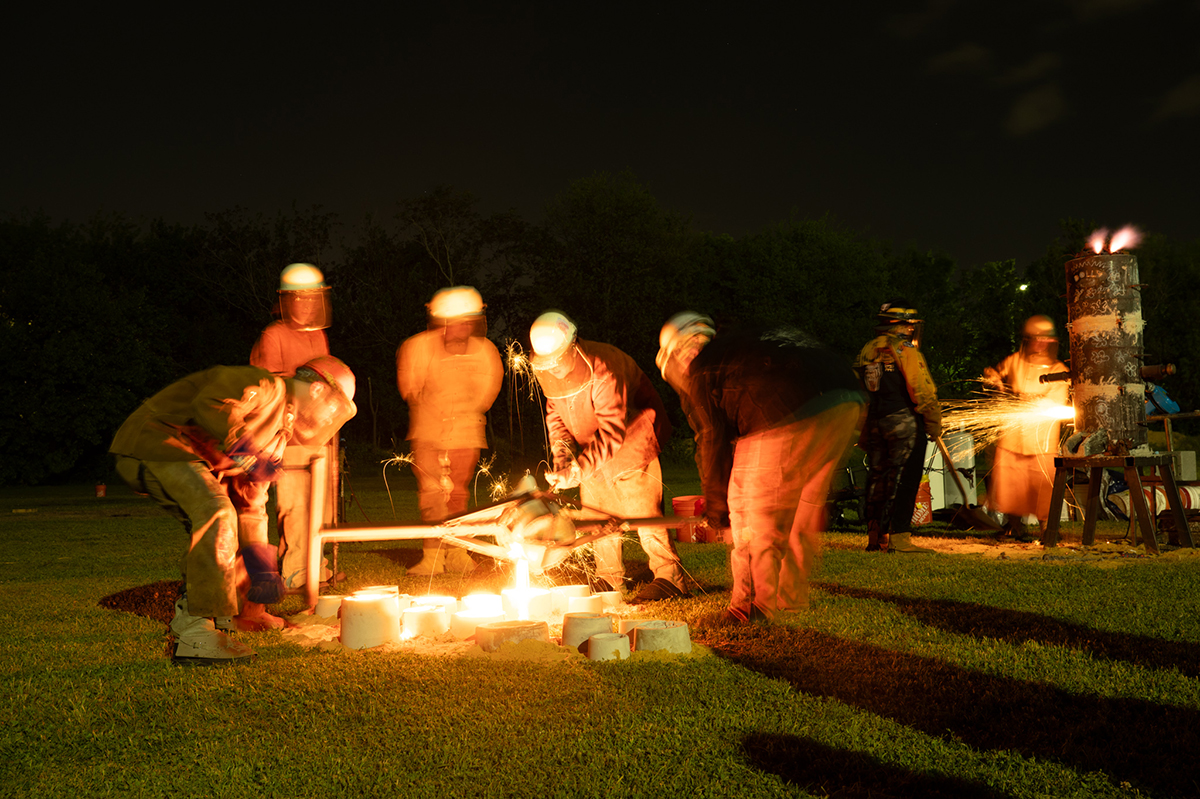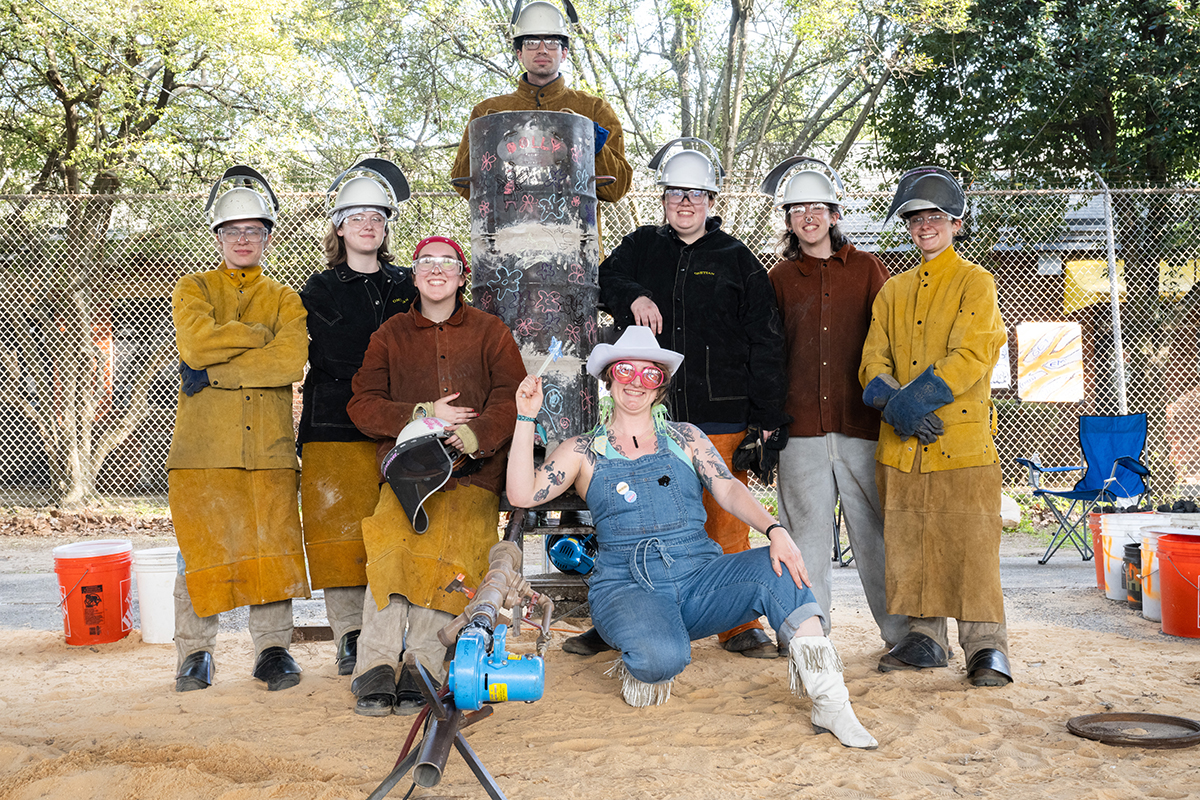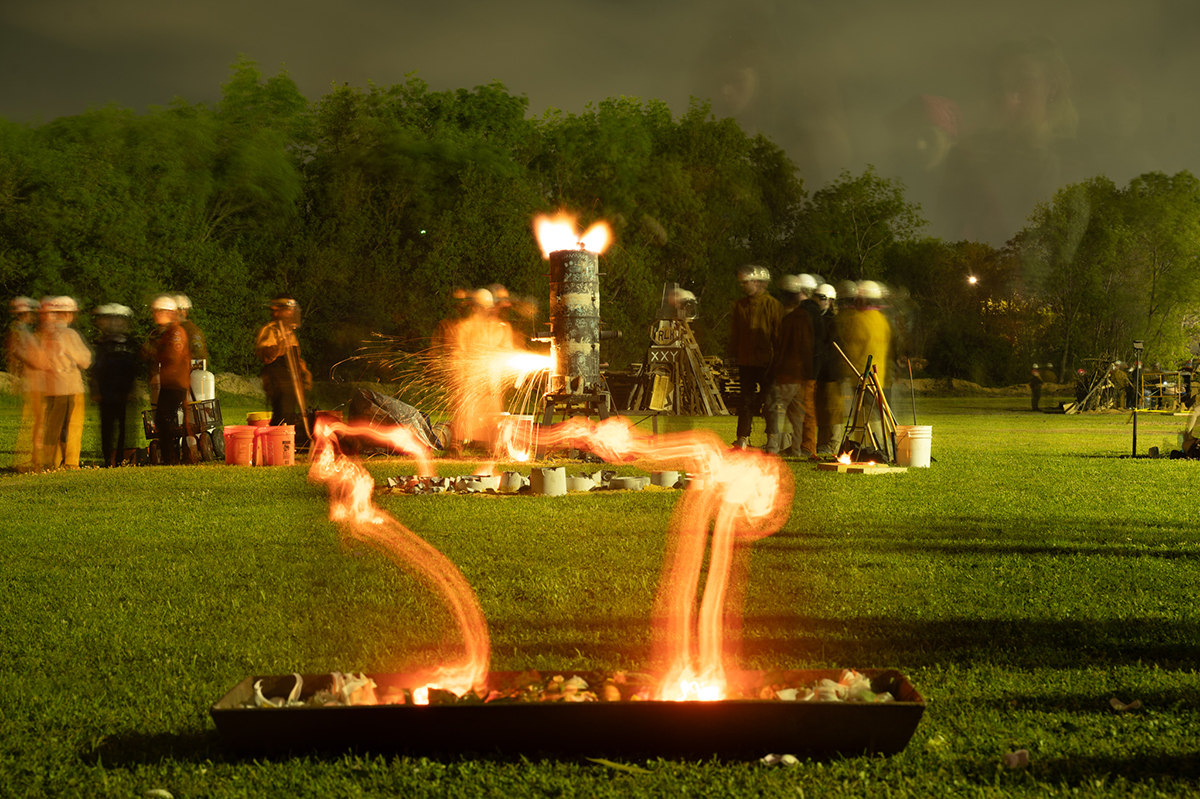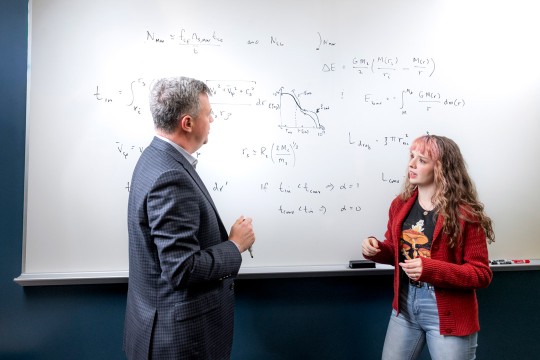RIT casts a bright light at national iron arts conference
Dan Hughes
Elizabeth Kronfield, Schools of Art and American Crafts director, places an array of flower petals in molds before molten iron from a student-built furnace is blended with the flowers.
One by one, Elizabeth Kronfield adds petals from roses, lilies, and hydrangeas into large molds patterned in a large, circular perimeter. Soon, onlookers are invited to assist with the petal-peeling process to fill the molds.
“It was quiet, subtle, and moving,” said Kronfield, director of RIT’s Schools of Art and American Crafts, and author of the hot iron performance titled Prelude to Hope. “Many of us cried silently while working with the flowers.”
Not far away, scrap iron melted at 3,000 degrees in an RIT student-made cupola furnace is poured into lotus flower-shaped molds. Kelly Wilton, instructional support specialist in the College of Art and Design, leads the merging of the hot-iron flowers — in their orange-red glowing glory — with the real flowers, eliciting a stimulating experience of vibrant light, satisfying sizzling, and floral aroma as the petals press against the hot iron.
The performance progressed from visualizing the hopeful feeling of new creation to what Kronfield describes as “hope burns.”
“That part of the performance symbolized the need for sacrifice to create something new, the concept and process of substitution, and literally ‘hope burns,’” Kronfield said.
“Prelude to Hope,” performed under a dusk-turned-dark southern sky, closed the 2025 National Conference on Contemporary Cast Iron Art and Practices (NCCCIAP). The conference was held in early April at Sloss Furnaces National Historic Landmark in Birmingham, Ala.
Between Kronfield, fellow staff and faculty, current undergraduate and graduate students, and alumni, RIT was present in every corner of the conference.
Dan Hughes
Students pour molten iron, melted in their cupola furnace, into molds during Kronfield's closing performance at NCCCIAP.
Kronfield wrote her performance with Shanti Thakur, director of the School of Film and Animation, who also came up with the title.
NCCCIAP’s juried exhibitions heavily featured work by students and alumni, including Parker Dubiel ’25 (studio arts BFA - sculpture and expanded forms option), Matt Mroz (fine arts studio MFA), Caleb Sykora-Bodie ’26 MFA (ceramics), and Wilton ’16 MFA (fine arts studio).
Students from RIT’s School of Art and School for American Crafts won the “Oscar” award in the Student Cupola competition, which challenges participating institutions to build a melting device capable of melting casting iron in a foundry setting. They earned the honor for building a highly-functioning furnace.
Wilton mentored the students in the fall and spring semesters on building and running a furnace.
“I wanted the students to be able to walk away with the knowledge on how to build and run a furnace with things they could easily find themselves if they wished to continue casting and build a cupola for their own studio practice,” Wilton said. “You can easily get lost in the aesthetics of your build, forgetting that the most important part is that it runs well.”
The cupola creators, from the ceramics MFA and studio arts BFA programs (furniture design, metals and jewelry design, and sculpture and expanded forms options), were: Chloe Cheatle, Parker Dubiel, Eden Handley (co-captain), Courtney Lougheed, Audrey Martignetti, Cece Plympton (co-captain), Caleb Sykora-Bodie, and Myles Vasta.
Dan Hughes
The RIT creators of "Dolly," their NCCCIAP award-winning cupola furnace.
The students took Wilton’s Foundry Practices class and collectivelty built the steel structure outside of their coursework. The affectionately named Dolly measured in at 3 feet wide and 6 1/2 feet tall.
“Each student utilized their strengths in building the cupola together,” Wilton said. “Sculpture and metals had more practice in welding and creating the steel structure, while furniture and ceramics had skills in precision and creating armatures for the refectory casting process. Everyone naturally fell into a role that they had the most passion for.”
Wilton competed in the same NCCCIAP cupola competition when she was an RIT graduate student. The experience ushered in a connection with the “wonderful” iron-casting community that has only grown stronger. In leading initiatives like this, she hopes another generation of artists is similarly impacted.
“These moments develop you into a reliable and hard-working artist,” Wilton said. “They are surrounded by so much knowledge. It also instantly gives these students good reputations if they decide to pursue master’s degrees or jobs at other universities that attend. It essentially acts as an in-person interview by showcasing their skills as a team.”
Wilton said as a direct result of connections made and the cupola work at the conference, Handley was awarded a prestigious Metals Arts fall internship at Rivers of Steel, a historic blast furnace complex in Pittsburgh, Pa. Handley, a metals and jewelry design student, is set to help with iron-casting workshops and the organization's annual Festival of Combustion, while also receiving a stipend to make original work.
Dan Hughes, lecturer of photographic sciences, photographed the “Prelude to Hope” performance as well as the cupola running in the student competition. Kronfield credits Hughes’ documentation as original artwork that displayed the “beauty and fierceness of molten iron.”
Hughes also scouted the Sloss Furnaces National Historic Landmark as a possible future RIT Big Shot location.
Dan Hughes
As flower-shaped molds filled with molten iron joined real flower petals during the "Prelude to Hope" performance, it filled the air with vibrant light and pleasant floral smells.
